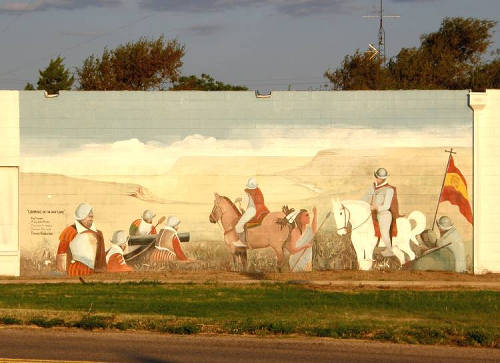| |
Even
if Texans wrote the history of Thanksgiving, arguments would persist over where
in Texas the alleged feast took place, and when.
In one corner would be the group proclaiming May 23, 1541, as the date of the
first Thanksgiving and Palo
Duro Canyon as the site. Spanish explorer Coronado would be the star of legend
and lore, and we'd probably be eating leftover buffalo
instead of turkey. |
 |
In the other corner
would be the people proclaiming an April 30, 1598, feast along the Rio Grande
the first Thanksgiving.
Both stories center on travesty and travail and
encounters with two of the most forbidding landscapes Texas
has to offer – the Llano Estacado and the Chihuahuan Desert. Surviving a 16th
Century trek across either landscape would be cause for thanks a plenty.
The
Palo Duro camp tells us that on May 23, 1541, a friar traveling with the
Coronado expedition proposed a service thanking God for his mercy and bounty.
Friar Juan de Padilla promptly performed a Thanksgiving Mass, which was witnessed
by a few baffled Teyas Indians.
We know too that Coronado and his men
suffered travails aplenty in their quest for Quivira, the richest of the Seven
Cities of Cibola, and that Coronado enlisted the aid of an Indian prisoner the
Spanish called La Turque (The Turk) because “he looked like one.”
La Turque
took the 1,500 men along with scores of horses, cattle and sheep on a hellish,
meandering tour of the Llano Estacado, a vast expanse of shortgrass prairie with
no settlements, no trees, very little water and nowhere to fix a compass. Coronado
and his men wandered in dazed circles for days on end, lost, hungry and thirsty
on an endless sea of grass. In this most desperate of states they made a final,
harrowing descent into the Palo Duro.
A hailstorm hit the canyon the first
night and stampeded the expedition's horses and destroyed much of their equipment.
Hunters ventured onto the plains to kill buffalo but the hunters got lost. Helpful
comrades built fires and blew trumpets to help them find their way back to the
canyon. Most of them eventually returned.
To this story, many historians
add a touch of balderdash. They point out that grapes and pecans, said to be a
part of the feast, did not grow in the Palo Duro at that time. “There is now some
doubt whether this was a special thanksgiving or a celebration of the Feast of
the Ascension. It was held in Texas, but may
have been on one of the forks of the Brazos River farther south,” wrote Mike Kingston
in an article written for the 1990-91 edition of the Texas Almanac.
The
Thanksgiving story of the Rio Grande River as the site of the first Thanksgiving
centers on Juan de Onate an aristocrat-turned explorer who set out to explore
territories he had been granted north of the Rio Grande. In 1597, he bypassed
a traditional route to blaze his own trail across the Chihuahuan Desert.
The
trek did not go well.
First, there was the endless rain, which they prayed
would stop. When it did, Onate and 500 people and several hundred head of livestock
nearly died of thirst. They went the last five days of the 50-day journey with
no food and no water. The expedition's arrival at the Rio Grande was its salvation.
After recuperating for 10 days, Onate ordered a day of Thanksgiving. The feast
consisted, we are told, of game hunted by the Spaniards and fish supplied by the
natives of the region. The Franciscan missionaries traveling with the expedition
said a mass. And finally, Onate read La Toma – the taking – declaring the
land drained by the Great River to be the possession of King Philip II of Spain.
A member of the expedition wrote of the original celebration, “We built
a great bonfire and roasted the meat and fish, and then all sat down to a repast
the like of which we had never enjoyed before.”
Some historians call this
one of the truly important dates in the history of the continent, marking the
beginning of Spanish colonization in the American Southwest.
Others call
it America's first Thanksgiving.
© Clay Coppedge
"Letters from Central Texas"
November 19, 2008 Column | |
|